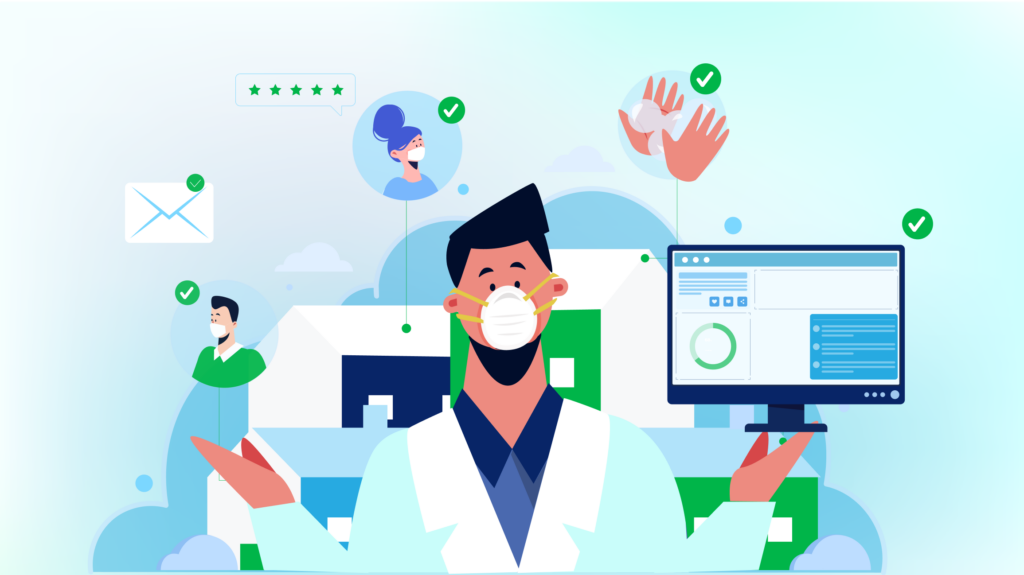Electronic Data Interchange (EDI) marked a significant milestone in the healthcare industry, revolutionizing how data is managed, processed, and exchanged. It is a technological solution that replaces traditional, manual paper-based data management with a streamlined, digital approach, thereby enhancing efficiency and security in healthcare operations.
Through EDI, healthcare providers can quickly process claims, accelerate information flow, and protect sensitive data — all of which contribute to improving patient care.
This blog post aims to provide you with a comprehensive understanding of healthcare EDI, its crucial role in the industry, and the ways emerging technology is further enhancing its capabilities. By the end of this article, you will have a robust understanding of its value in healthcare data integration, key considerations for implementing EDI software solutions, and how this powerful tool can transform your healthcare system.
What Is Electronic Data Interchange In Healthcare?

Electronic data interchange (EDI) enables computer-to-computer exchange of business documents between business partners using a standard, secure connection.
Consider an analogy: It’s like having an English speaker converse with a Russian speaker, with both requiring a translator to bridge the communication gap. They need a third person to translate for both sides. That is the role of EDI: to act as an interpreter for both system A and system B to synchronize data seamlessly.
For numerous decades, EDI has played a vital role in facilitating the exchange of healthcare-related information, including claims, remittance advice, eligibility verification, and prior authorization requests, between healthcare organizations, payers, and providers. Its longstanding implementation underscores its significance in enhancing efficiency and collaboration within the healthcare ecosystem.
Today, covered entities that exchange medical information electronically (health plans, clearinghouses, and care providers) must adopt uniform standards for all healthcare EDI transactions, according to the HIPAA EDI rule. HIPAA EDI compliance requires healthcare organizations to use the ASC X12 protocol when sending PHI documents.
The ASC X12 protocol is the only acceptable format for HIPAA EDI transactions. This single medical standard serves as a bridge language to connect the computer systems of various healthcare organizations in the US. This seamless integration fosters streamlined operations, eliminates variation between them and makes the exchanges more secure.
What Makes EDI in Healthcare So Unique?

In the US healthcare ecosystem, EDI plays a crucial role in solving payment-related challenges. However, data transmission in the healthcare industry is complicated. The sheer amount of data generated by this industry can affect any system’s efficiency, especially when it comes to cybersecurity. Therefore, healthcare providers adopting EDI must adhere to HIPAA regulations and ANSI standards.
EDI establishes specific data and document formats for various transactions across industries. Within the healthcare sector, there are nine primary EDI transaction sets, each designated by a unique number:
-
- Eligibility benefit inquiry and response (270 and 271): Providers send a benefit inquiry (270) to payers, and payers respond (271) with either an eligibility confirmation or a reason for rejection (such as incomplete or incorrect format).
-
- Claims information (837): Providers use this transaction to either request payment for a claim or provide encounter information.
-
- Payment and remittance advice (835): After a provider sends an 837 payment request, the payer will respond with an 835 transaction to document the payment and explain any claim adjustments.
-
- Claim status request (276): Providers use this transaction to request the status of a previously submitted claim from the payer.
-
- Claim status notification (277): Payers use this transaction to update providers on claim status.
-
- Care service review (278): Hospitals use this transaction to request prior authorization for patient service from a payer.
-
- Benefits enrollment (834): Employers, unions, government agencies, associations, and payers use 834 to enroll new members in a health plan, manage or change their status, and remove or reinstate them.
-
- Payment order and remittance advice (820): Companies use this transaction to send payment instructions to banks, provide pending payment details to suppliers, and send the premium payment information to payers.
What Are the Benefits of Healthcare EDI?

According to Zion Market Research, demand for the healthcare EDI market is expected to generate revenue of around $5928.07 million by the end of 2025. Drivers for this substantial growth are the various benefits healthcare EDI offers for healthcare providers and payers, including:
-
- Standardization: The primary goal of HIPAA in utilizing EDI is to establish national and global standards for electronic healthcare transactions. By leveraging HIPAA EDI transactions, healthcare data can be exchanged in an organized, compliant, accurate, and efficient manner.

-
- Cost savings: Implementing EDI healthcare transactions can reduce processing costs of healthcare documents by automating processes and eliminating paper-based transactions. According to WEDI estimates, this can result in substantial savings for health payers: $1 per claim for health plans, $1.49 for physicians, $0.86 for hospitals, and $0.83 for others.
-
- Security: Healthcare EDI systems facilitate the secure exchange of information between healthcare providers and payers or insurers. By leveraging it, healthcare transactions are now more secure, aligning with the mandated HIPAA standards for secure data transmission. Access to EDI transactions in healthcare is also limited to authorized users, promoting robust healthcare data management and secure access.
-
- Enhanced accuracy: HIPAA EDI software solutions streamline essential transactions in medical organizations, improving efficiency and reducing human errors. These errors encompass typos, incorrect entries, as well as lost faxes and mail. Furthermore, all EDI files undergo meticulous testing and validation for the highest accuracy.
-
- Improved productivity: It enhances productivity by facilitating instant data transactions with multiple parties. It reduces denials and rework requests and eliminates the need to confirm information receipt. As a result, recipients receive the required data faster with higher accuracy, establishing an efficient and error-free process.
Leveraging Benefits Of EDI To Drive Real-World Use Cases

EDI has been instrumental in transforming the healthcare industry by facilitating a more efficient, secure transmission of healthcare data. The adoption of it in the healthcare industry has been mandated in the U.S. through legislation such as HIPAA, with other countries following suit.
To gain a deeper insight into the growing importance of healthcare EDI, let’s explore the remarkable advancements that this technology has ushered into the healthcare industry.
-
- Claims Processing: One of the primary uses of EDI in healthcare is managing insurance claims. Healthcare providers use it to electronically submit claims to insurance companies in a standardized format (typically ANSI X12 837). This electronic claim not only reduces the time and resources required to process claims but also enhances reimbursement speed and cash flow for healthcare organizations.
-
- Eligibility Verification: Healthcare providers have to verify a patient’s eligibility for healthcare services before providing services. With EDI, they can send an eligibility request to the insurance company and receive an immediate response detailing the patient’s insurance coverage, reducing the risk of errors and improving the efficiency of healthcare operations.
-
- Payment and Remittance: EDI also simplifies the payment process. Insurance companies can use it to send payment advice (ANSI X12 835) to providers, detailing what has been paid, denied, or needs further explanation. This makes it easier for providers to reconcile claims and payments more efficiently with their records.
-
- Referrals and Authorizations: A referral or authorization is often necessary when a patient needs to see a specialist or requires a specific service. EDI allows healthcare organizations to electronically exchange these referrals and authorizations between healthcare providers, speeding up the process and improving care coordination.
-
- Laboratory Orders and Results: In the lab, EDI is used to automate the process of lab orders and results. A healthcare provider can send an electronic order to a lab, and the lab can return the results when ready. This improves speed, eliminates paperwork, and reduces errors. This integration not only reduces the chances of misinterpretation due to manual entry but also ensures that results are directly integrated into the patient’s EHR.
-
- Pharmacy Transactions: Pharmacies use EDI to manage transactions such as prescription dispensing and benefits coordination. The National Council for Prescription Drug Programs (NCPDP) has also provided the EDI standards commonly used in pharmacy transactions, speeding up the billing process (and receiving payments) so that pharmacies don’t have to play the waiting game to be paid.
What Does the Future Hold for EDI in Healthcare?

The global healthcare EDI market has been a cornerstone of digital transformation in the healthcare sector and is expected to grow at a steady CAGR of 11.45% from 2023 to 2032. As we look toward the future, several key trends and developments suggest continued growth and evolution in this space.
Firstly, the advent of application programming interface (API) technology offers real-time data exchange capabilities to augment existing EDI systems. APIs offer more flexibility and speed compared to the traditional EDI, making them ideal for tasks requiring immediate response, such as eligibility checks or appointment scheduling.
The future of EDI in healthcare will also be shaped by its integration with emerging technologies. Specifically, AI can enhance EDI systems’ predictive capabilities, enabling proactive inventory management or patient care; IoT devices can feed real-time data into EDI systems, improving monitoring and decision-making; and blockchain can enhance the security and traceability of EDI transactions, fostering trust among stakeholders.
As cybersecurity threats continue to evolve, the importance of data security in EDI systems cannot be overstated. Advanced encryption techniques, stringent access controls, and secure protocols will be integral to the EDI systems of the future.
Additionally, compliance with data protection regulations like GDPR and HIPAA will continue to shape the development of EDI systems. Future solutions must ensure robust data privacy and security features to comply with these and potential new regulations.
With technological advancements and an evolving regulatory landscape, EDI systems will become even more integral to healthcare operations, offering improved efficiency, security, and patient care. As a result, more and more healthcare organizations will seek professional assistance to jump into this tech.
How To Choose The Right Technical Partner For Your EDI Project?

Healthcare EDI is no longer a nice-to-have; it’s a must. Ignoring it puts you at risk of outdated and inaccurate information, not to mention potential regulatory fines. But how do you find the right technical partner to help you plan the integration?
First and foremost, seek a technical supplier with extensive experience in the healthcare sector. The chosen managed services company should possess in-depth knowledge and expertise in EDI, FHIR, and other sophisticated healthcare technologies that may be required for the project.
Secondly, it’s crucial that your technical partner can meet the service level agreements (SLAs) and regulatory standards that you adhere to.
Lastly, ensure that your technical partner can deliver a solution that remains viable in the long term. New advances appear in healthcare every single day, and you must keep your healthcare EDI updated with those latest standards.
By considering these factors, you can make an informed decision and secure a reliable technical partner for your healthcare EDI project. And in case you need further advice in selecting the ideal technical partner, see how our CTO, Kaushal Amin explores seven qualities to look for in a health tech outsourced company.
What’s Next? Let KMS Healthcare Do The Heavy Lifting Part For You
Integrating EDI is a complex task that demands advanced programming skills and practical knowledge of HIPAA standards. Without a proficient healthcare development team, you might run the risk of investing in software that fails to perform its functions properly and may even result in HIPAA violations.

KMS Healthcare has been in the industry for decades. Our experts can consult you on EDI implementation, create a custom-tailored healthcare management solution or fine-tune your existing one so it complies with all regulatory requirements.
We understand your healthcare needs and want to forge a long-term collaboration with you. Contact us today to embark on our journey of integrating EDI into your healthcare business.

